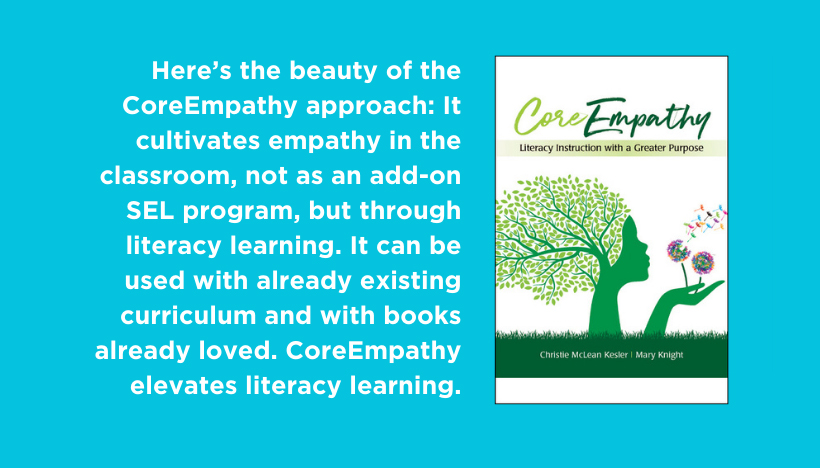This post was written by Mary Knight and Christie McLean Kesler.
“As our book, CoreEmpathy: Literacy Instruction with a Greater Purpose, is finding its way into the world this spring, we are at once awestruck and grateful for its timeliness as one answer to three of the greatest challenges teachers face this fall.”
What a year.
We began developing CoreEmpathy—an approach to literacy instruction that cultivates empathy in the classroom—over seven years ago. At the time, a global pandemic wasn’t on anyone’s radar. Sadly, school shootings and a major uptick in bullying were all major concerns in schools across the country then as now, but the entire world of education going online?
Unimaginable.
And yet, imagine it we did. And now, imagining “a new normal” we must, as we transition from safe learning at home to safe learning in the classroom.
CoreEmpathy can help.
Challenge #1: How do we foster a healthy classroom environment when so many of our students will return to us feeling traumatized and anxious?
In addition to using empathy as a reading and writing lens, CoreEmpathy inspires a safe and nurturing classroom where participants feel they belong.
Tiffany, a second- and third-grade teacher from a school district in Charleston, West Virginia, discovered that as soon as she introduced empathy into her classroom, students started feeling safer to share experiences from their own lives. Since many of their personal stories related to issues of poverty, classmates began to empathize with each other, she says, resulting in a radical increase of kindness both inside and outside the classroom.
Because empathy builds common ground, it also builds community.
Challenge #2: How do we even begin to make up for the academic losses many of our students have sustained?
Here’s the beauty of the CoreEmpathy approach: It cultivates empathy in the classroom, not as an add-on SEL program, but through literacy learning. It can be used with already existing curriculum and with books already loved. CoreEmpathy elevates literacy learning.
In their report, From a Nation at Risk to a Nation at Hope (http://nationathope.org/report-from-the-nation/), the National Commission on Social, Emotional, and Academic Development writes, “It is a mistake to view social and emotional learning as a ‘soft’ approach to education. Quite the opposite. An emphasis on these capacities is not the sacrifice of rigor; it is a source of rigor. While many elements of a child’s life improve along with the cultivation of these skills, one of the main outcomes is better academic performance.”
Teachers tell us that they witness this “rigor” in their students’ work when engaging CoreEmpathy. “The learning just kept getting deeper and more interesting to them,” a first-grade teacher, Laura, says of her students’ response to empathy-infused reading. “They were living the books. . . . I was originally attracted to this approach for the empathy alone, but I quickly realized this was the best thing I could have done for my students to teach them to become stronger readers and writers.”
We’ve carefully integrated empathy-infused reading and writing instruction so that one set of skills supports the other. For instance, as students read and notice where they feel empathy for a character, they might also look for the authors’ craft strategies for engaging readers in that level of caring.
“Reading is about understanding. Every reader I’ve taught has confirmed it also. They love reaching the core of a text because that’s where their heart and mind come together to love reading. If ‘reading is to the mind what exercise is to the body’ as Joseph Addison says, then empathy is here to infuse new heights to the mind.” —Christie McLean Kesler, coauthor
“When you teach empathy-infused writing, your students will show a deeper level of engagement and understanding of the writing process, and their writing will show that depth, too. I’ve discovered, for instance, that this approach inspires student writers to develop their own unique voices—one small part of that intangible empathy effect that may be impossible to measure, and yet you know it’s there because you see it in your students’ work.” —Mary Knight, coauthor
Challenge #3: How do we nurture ourselves as we do this difficult work?
It’s depleting, isn’t it? With our passion focused on helping students learn, attention toward ourselves often suffers. Challenges in the coming months will be successfully met as we learn how to nurture ourselves in the process. Just as we’re instructed on a plane to “put our oxygen mask on first,” we must first offer ourselves and our colleagues empathy, not only to sustain ourselves in our work, but also to actualize teaching’s greater purpose—to make a difference in our students’ lives.
It is our belief that the suggestions and strategies offered in CoreEmpathy will inspire you to live your greater purpose with unimaginable joy.
 Christie McLean Kesler is a literacy specialist, professional developer, teacher, and writer in the Pacific Northwest. She is currently a Senior Instructor at Western Washington University where she has been teaching and mentoring pre-service teachers for over two decades. Her love for teaching and learning began in the elementary classroom.
Christie McLean Kesler is a literacy specialist, professional developer, teacher, and writer in the Pacific Northwest. She is currently a Senior Instructor at Western Washington University where she has been teaching and mentoring pre-service teachers for over two decades. Her love for teaching and learning began in the elementary classroom.
 Mary Knight is a frequent presenter and writing workshop facilitator at schools and conferences around the country. Her novel, Saving Wonder (Scholastic) was the winner of the 2017 Green Earth Book Award for Children’s Fiction, a Parents’ Choice award, and was selected as a Notable Book for Social Studies by the Children’s Book Council. She is also a writing mentor at the Carnegie Center for Literacy and Learning in Lexington, Kentucky.
Mary Knight is a frequent presenter and writing workshop facilitator at schools and conferences around the country. Her novel, Saving Wonder (Scholastic) was the winner of the 2017 Green Earth Book Award for Children’s Fiction, a Parents’ Choice award, and was selected as a Notable Book for Social Studies by the Children’s Book Council. She is also a writing mentor at the Carnegie Center for Literacy and Learning in Lexington, Kentucky.
You can contact both authors/presenters at www.CoreEmpathy.com.
It is the policy of NCTE in all publications, including the Literacy & NCTE blog, to provide a forum for the open discussion of ideas concerning the content and the teaching of English and the language arts. Publicity accorded to any particular point of view does not imply endorsement by the Executive Committee, the Board of Directors, the staff, or the membership at large, except in announcements of policy, where such endorsement is clearly specified.

